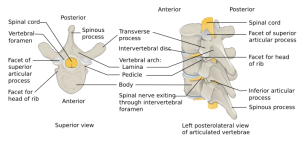The printable version is no longer supported and may have rendering errors. Please update your browser bookmarks and please use the default browser print function instead.
Background
- Defined as those involving the transverse process only, without extension into the pedicle, lamina, or facet complex.
- Are not associated with any ligamentous or structural injury that can contribute to spinal instability or spinal cord compromise.
- Systematic literature review reveals 819 documented cases, with none requiring surgical intervention[1][2][3][4]

Numbering order of vertebrae.
Clinical Features
Differential Diagnosis
- Airway/Pulmonary
- Cardiac/Vascular
- Musculoskeletal
- Other
- Spine related
- Renal disease
- Intra-abdominal
- Pelvic disease
- Other
Evaluation

Lumbar spine antero-posterior x-ray showing fractures of left L2 and L3 transverse processes (arrows).
Workup
- CT scan (gold standard)
- Consider additional trauma workup, as transverse process fractures may be indicators of other more serious injuries
Evaluation
- Diagnosed typically on CT
Management
Adults (>15 years old)
- Pain management, early mobilization, and unrestricted movement
- Do not require surgical intervention
- Immobilization via cervical collar, brace (e.g. TLSO), halo vest is not necessary
- May hinder patient recovery (e.g. inhibit pulmonary function, increase intracranial pressure, pressure sores, increased medical costs)
- The following types do not require spine specialist consult (e.g. neurosurgery, orthopedics):[5][6]
- Subaxial cervical spine (C3-C7) without involvement of the transverse foramen
- Involvement of the transverse foramen may suggest a possible vertebral artery injury and should be pursued with further evaluation and spine specialty consult.
- Thoracic (all)
- Lumbar (all)
Pediatric Patients (<15 years old)
- Same as for adults, except only thoracolumbar spine fractures do not require spine specialist (e.g. neurosurgery, orthopedics) consultation[7]
Disposition
See Also
External Links
References
- ↑ Schotanus M, van Middendorp JJ, Hosman AJ. Isolated transverse process fractures of the subaxial cervical spine: a clinically insignificant injury or not?: a prospective, longitudinal analysis in a consecutive high-energy blunt trauma population. Spine (Phila Pa 1976). 2010; 35(19): E965-70.
- ↑ Bradley LH, Paullus WC, Howe J, Litofsky NS. Isolated transverse process fractures: spine service management not needed. J Trauma. 2008; 65(4): 832-6; discussion 6.
- ↑ Homnick A, Lavery R, Nicastro O, Livingston DH, Hauser CJ. Isolated thoracolumbar transverse process fractures: call physical therapy, not spine. J Trauma. 2007; 63(6): 1292-5.
- ↑ Akinpelu BJ, Zuckerman SL, Gannon SR, Westrick A, Shannon C, Naftel RP. Pediatric isolated thoracic and/or lumbar transverse and spinous process fractures. J Neurosurg Pediatr. 2016: 1-6.
- ↑ Schotanus M, van Middendorp JJ, Hosman AJ. Isolated transverse process fractures of the subaxial cervical spine: a clinically insignificant injury or not?: a prospective, longitudinal analysis in a consecutive high-energy blunt trauma population. Spine (Phila Pa 1976). 2010; 35(19): E965-70.
- ↑ Bradley LH, Paullus WC, Howe J, Litofsky NS. Isolated transverse process fractures: spine service management not needed. J Trauma. 2008; 65(4): 832-6; discussion 6.
- ↑ Akinpelu BJ, Zuckerman SL, Gannon SR, Westrick A, Shannon C, Naftel RP. Pediatric isolated thoracic and/or lumbar transverse and spinous process fractures. J Neurosurg Pediatr. 2016: 1-6.





